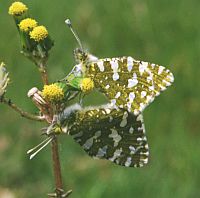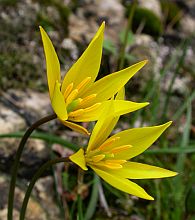 |
Altiplano de Azóia
A Special Protection Area for Birds (3,416ha) and rich in other wildlife, this bleak, windswept
limestone promontory is essentially a westerly extension of the Serra da Arrábida, which
terminates in the spectacular cliffs of Cabo Espichel. The plateau is renowned for its
cushions of the Portuguese endemic gorse Ulex densus and the thyme Thymus villosus, confined
 Ophrys fusca ssp. dyris
© Teresa Farino
to the Iberian peninsula, growing amid a mosaic of other woody species such as French lavender,
lentisc, holly oak, narrow-leaved and grey-leaved cistuses and Cistus crispus. Towards the sea,
a second, lower plateau has more sandy soils, supporting a taller scrub composed of rather
calcifuge species such as gum and sage-leaved cistuses and green heather, with open ground
hosting the diminutive allseed and yellow centaury, plus the delicate white flowers of the
boraginaceous Omphalodes linifolia.
Ophrys fusca ssp. dyris
© Teresa Farino
to the Iberian peninsula, growing amid a mosaic of other woody species such as French lavender,
lentisc, holly oak, narrow-leaved and grey-leaved cistuses and Cistus crispus. Towards the sea,
a second, lower plateau has more sandy soils, supporting a taller scrub composed of rather
calcifuge species such as gum and sage-leaved cistuses and green heather, with open ground
hosting the diminutive allseed and yellow centaury, plus the delicate white flowers of the
boraginaceous Omphalodes linifolia.
 Western Dappled Whites
Western Dappled Whites
Euchloe crameri
© Teresa Farino
These scrubby habitats, studded with a few eucalypts, are populated by quail, crested lark,
fan-tailed, Sardinian and Dartford warblers, waxbill, spotless starling, serin and corn bunting,
with southern grey shrikes commonly seen hunting over more open areas, while woodlark,
black-eared wheatear and cirl bunting inhabit the more sheltered and wooded valleys around
Facho de Azóia. Spring butterflies on the plateau include swallowtail, clouded yellow,
Cleopatra, western dappled and green-striped whites, wall brown, Spanish brown argus, small
copper and green hairstreak.
Short-toed larks breed in the nearby cereal fields, which also attract wintering hen harrier
and golden plover, while typical cliff-nesters include peregrine, pallid swift, black redstart
and blue rock thrush. For birdwatching enthusiasts, large numbers of trans-Saharan migrants
turn up in autumn, including occasional surprises such as Eleonora's and red-footed falcons,
 Wild Tulips
Wild Tulips
Tulipa sylvestris ssp. australis
© Teresa Farinodotterel, Richard's pipit and roller, while sea-watchers should be rewarded by Cory's and
Balearic shearwaters and gannet.
Limestone pavement on the Altiplano boasts all the Arrábida spring-flowering monocots -
perhaps in even greater abundance here in March, when drifts of orchids and wild tulips are to be found -
with the addition of Ornithogalum orthophyllum, dipcadi, the autumn-flowering sea squill,
sword-leaved helleborine, woodcock ophrys and Ophrys fusca ssp. dyris. The south-facing cliffs harbour
the tree-spurge Euphorbia pedroi and the woody, white-flowered convolvulus Convolvulus
fernandesii (both unique to Espichel), plus fagonia, sea mallow, Eryngium dilatatum,
small blue convolvulus, the Iberian endemic figwort Scrophularia sublyrata and the
solanaceous shrub Withania frutescens. At the top of these cliffs, limestone outcrops provide
niches for attractive wildflowers such as the fern Cheilanthes acrostica, Malling toadflax, honeywort, annual bellflower and
grape-hyacinth.
|